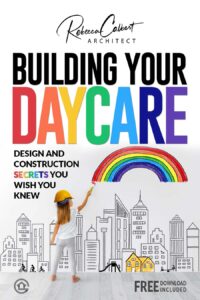14 Tips for the Best Daycare and Floorplan Design
Childcare facilities are an essential component of modern society, providing a safe and nurturing environment for children to learn and grow. A well-designed daycare facility is crucial in creating an environment that is both functional and aesthetically pleasing, ensuring that children receive the care they need, and parents feel confident in the care they are receiving.
One of the most important elements of a daycare facility is the floor plan design. A well-designed floorplan can make a significant difference in the functionality and effectiveness of a daycare center, while also ensuring that the space is safe and comfortable for children.
The design of a daycare center is crucial for the safety and well-being of children in care. A well-designed daycare floor plan can provide a safe and stimulating environment that promotes learning, socialization, and development. In this article, we will explore some daycare floorplan design tips to help create a safe and functional environment for children.
Having a well-designed daycare facility is important for several reasons, as it can have a significant impact on the safety, health, and overall well-being of children who attend the center. Here are some reasons why a well-designed daycare facility is crucial:
Safety
A well-designed daycare facility is essential for ensuring the safety of the children who attend. Proper design and layout can help reduce the risk of accidents and injuries, such as trips and falls, and can also help ensure that the facility is secure and free from potential hazards.
Health
A well-designed daycare facility can promote good health among children who attend. Features such as natural light, good ventilation, and appropriate use of space can help reduce the spread of illnesses and promote a healthy environment for children.
Learning and Development
A well-designed daycare facility can also play a critical role in promoting learning and development among children who attend. A space that is designed to encourage exploration, creativity, and social interaction can help children develop important skills and prepare them for success in school and beyond.
Staff Productivity and Satisfaction
A well-designed daycare facility can also have a positive impact on staff productivity and satisfaction. A comfortable and functional workspace can help staff work more efficiently and effectively, while also promoting a positive work environment.
Parent Satisfaction
A well-designed daycare facility can also impact parent satisfaction. Parents want to feel confident that their children are in a safe and nurturing environment, and a well-designed facility can help provide that peace of mind.
In addition to these benefits, a well-designed daycare facility can also help attract and retain families and staff, which can have a significant impact on the success and sustainability of the center. Overall, investing in a well-designed daycare facility is an important step toward providing high-quality care for children and ensuring their long-term success.
Designing a daycare center can be a challenging task, as it requires creating a space that is both safe and inviting for children.
One of the most important aspects of designing a daycare center is the floor plan. The layout of the space can impact everything from the flow of traffic to the ability to monitor children effectively. In this article, we will explore some daycare floor plan design tips that can help you create a safe and functional space for children to learn and grow.
The following are our favorite daycare floorplan design tips that can help you create a functional and inviting space for children.
Tip #1 – Create a Welcoming Entrance.
The entrance to your daycare facility is the first impression that parents and children will have of your center.
Consider incorporating elements such as bright colors, artwork, and comfortable seating to create a welcoming and inviting entrance. You should also include a reception desk or check-in area where parents can sign their children in and out and touch base with the administrative staff.
Creating a welcoming entrance for a daycare center business is important for several reasons.
First Impressions
Creating a welcoming entrance can set the tone for the rest of the facility and make a positive first impression. The entrance is the first point of contact for parents and children visiting the daycare center. A well-designed and welcoming entrance can create a positive first impression and set the tone for the entire experience.
Safety
A welcoming entrance can also help ensure that parents and children feel safe and secure when entering the facility. By clearly marking the entrance and creating a secure access point, parents can feel confident that their children are in a safe environment.
Comfort
Entering a daycare center can be a stressful experience for both parents and children. A welcoming entrance can help create a comfortable and inviting environment that eases any anxiety and promotes a positive experience for everyone.
Branding
A well-designed entrance can also help reinforce the branding and image of the daycare center. Incorporating the center’s logo, colors, and messaging into the design of the entrance, can help create a cohesive and memorable brand experience for parents and children.
Marketing
Finally, a welcoming entrance can also be an effective marketing tool. A visually appealing and welcoming entrance can catch the attention of passersby and help attract new families to the daycare center.
Overall, creating a welcoming entrance for a daycare center business is an essential part of creating a positive experience for parents and children. It helps promote safety, comfort, branding, and marketing and can have a significant impact on the success and sustainability of the center.
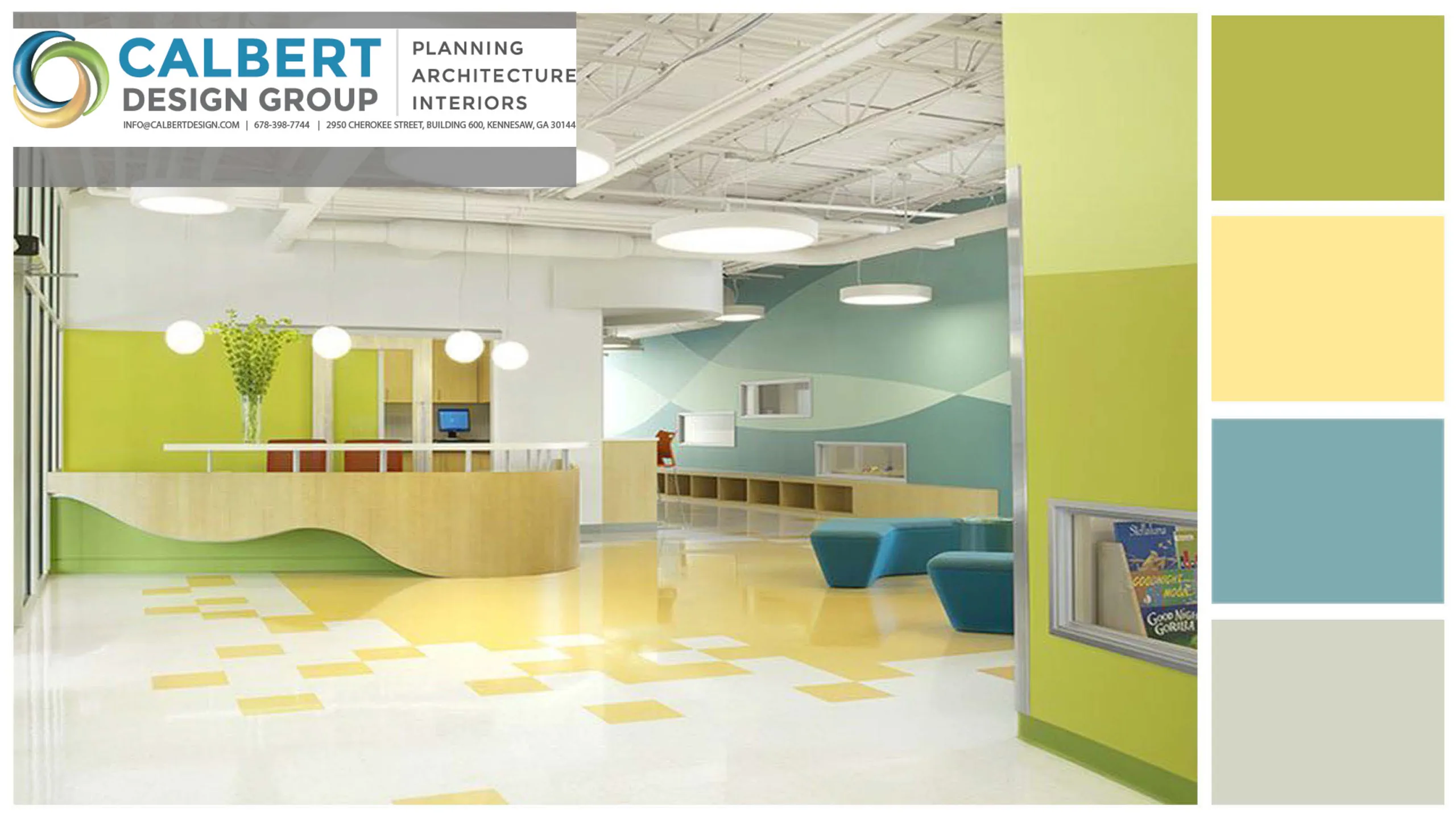
Tip #2 – Design Functional and Flexible Spaces.
Daycare facilities need to be flexible spaces that can accommodate a range of activities and needs. When designing your floor plan, consider how you can create spaces that are both functional and flexible.
For example, you may want to incorporate multi-use rooms that can be used for a range of activities, such as arts and crafts, reading, and quiet time. You may also want to incorporate outdoor play areas that can be used for a range of activities, such as active play, gardening, and sensory exploration.
Designing flexible spaces in a daycare floor plan is important for several reasons. Here are some reasons why:
Adaptability
Flexible spaces allow for the daycare center to adapt to the changing needs of children and families. For example, if enrollment numbers increase or decrease, flexible spaces can be reconfigured to accommodate those changes without requiring major renovations or redesigns.
Multi-functionality
Flexible spaces can also serve multiple functions. A room that is used as a play area during the day can be easily transformed into a classroom or a meeting space for parent-teacher conferences in the evening.
Customization
By designing flexible spaces, daycare centers can customize the environment to meet the unique needs of their children and families. For example, if a group of children has a particular interest in art, a flexible space can be designed to accommodate their artistic pursuits.
Cost-Effective
Designing flexible spaces can be cost-effective in the long run. Rather than having to build new spaces or redesign existing spaces every time there is a change in the needs of the daycare center, flexible spaces can be easily adapted to meet those needs, saving time and money.
Stimulating Environments
Flexible spaces can help create a more stimulating environment for children. Spaces that can be reconfigured and customized can promote creativity, exploration, and problem-solving skills among children, which can help with their development and learning.
Overall, designing flexible spaces in a daycare floor plan can help daycare centers adapt to changing needs, serve multiple functions, customize the environment, save costs, and promote a stimulating environment for children.
Tip #3 – Consider the Flow of the Space.
Another important consideration when designing a daycare center is the flow of pedestrian traffic within the building. You will need to plan for how children will move throughout the space, as well as how staff will move between different areas. This can help to reduce congestion and ensure that everyone can move through the space safely and efficiently.
The flow of the space is an important consideration when designing a daycare facility. You want to create a space that is easy to navigate and allows for a smooth flow of children and staff.
Considering the flow of the space in a daycare floorplan is important for several reasons.
Safety
The flow of space in a daycare center can impact the safety of the children who attend. For example, if the flow of space is designed in such a way that children frequently cross paths with staff or other children in high-traffic areas, it can increase the risk of accidents and injuries. By considering the flow of space, daycare centers can help reduce the risk of accidents and create a safer environment for children.
Efficiency
The flow of space in a daycare center can impact the efficiency of operations. If the layout is poorly designed, it can lead to congestion, delays, and inefficiencies in staff and child movement. By considering the flow of space, daycare centers can optimize the use of space and create a more efficient and productive environment for staff and children.
Comfort
The flow of space can also impact the comfort and well-being of the children who attend. If the layout is designed in a way that creates congestion or overcrowding, it can lead to discomfort and stress among children. By considering the flow of space, daycare centers can create a comfortable and inviting environment that promotes positive experiences for children.
Functionality
The flow of space can impact the functionality of a daycare center. For example, if the layout is designed in a way that makes it difficult for staff to monitor children or provide care, it can impact the quality of care provided. By considering the flow of space, daycare centers can design a space that is functional and meets the needs of staff and children.
Aesthetics
The flow of space can also impact the overall aesthetic of a daycare center. A well-designed flow can create a visually appealing environment that promotes a positive image and creates a welcoming atmosphere for children and families.
Overall, consider how you can design your floor plan to create clear pathways and minimize congestion. You may want to incorporate wide hallways, clear signage, and designated drop-off and pick-up areas to help facilitate the flow of children and staff.
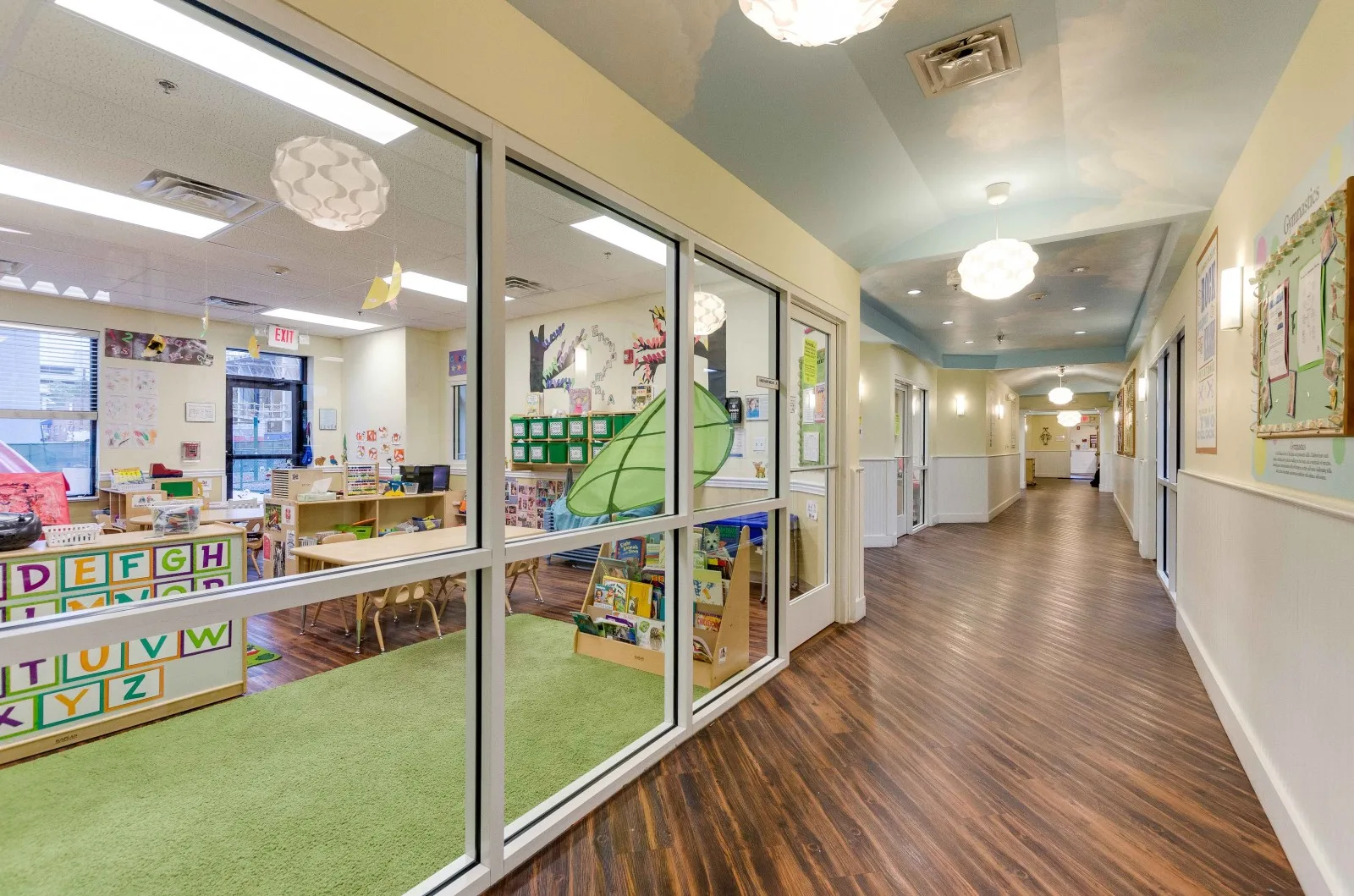
Tip #4 – Incorporate Natural Light.
Incorporating natural light into your daycare center can have numerous benefits. Not only can it help to create a warm and welcoming environment, but it can also improve mood and promote better sleep patterns. Additionally, natural light can help to reduce the need for artificial lighting, which can help to save on energy costs.
Natural light is essential for creating a welcoming and inviting space, and it can also have a positive impact on children’s moods and behavior. When designing your floor plan, consider how you can incorporate natural light into your space.
This may involve incorporating large windows, skylights, or glass doors that allow natural light to flood into the space. You may also want to consider adding outdoor spaces, such as a courtyard or garden, that allow children to experience natural light and fresh air.
Incorporating natural light into the design of a daycare building floorplan is important for several reasons:
Health and Well-being
Natural light has a positive impact on human health and well-being. Exposure to natural light can help regulate the body’s circadian rhythm, which helps promote better sleep, mood, and overall health. Children who are exposed to natural light tend to be more alert, active and engaged, which can have a positive impact on their development.
Energy Efficiency
Incorporating natural light into the design of a daycare building can help reduce energy costs. By using natural light, you can reduce the need for artificial lighting, which can save energy and money.
Aesthetics
Natural light can create a warm and inviting atmosphere in a daycare building. It can make the space feel brighter, more open, and more welcoming. This can help create a positive first impression for parents and children who are visiting the daycare for the first time.
Learning and Play
Natural light can enhance learning and play. It can create a more stimulating environment for children, which can help promote their creativity, imagination, and cognitive development.
Overall, incorporating natural light into the design of a daycare building floorplan can have a positive impact on the health and well-being of children, reduce energy costs, create a welcoming atmosphere, and enhance learning and play.
Tip #5 – Consider Acoustics and Noise Control.
Acoustics are an important consideration when designing a daycare facility. You want to create a space that is not only visually appealing but also comfortable for children to be in.
Consider how you can design your floor plan to minimize noise and create a peaceful and calm environment. This may involve incorporating sound-absorbing materials, such as carpets and acoustic tiles, and designing spaces that are acoustically isolated from each other.
Considering acoustics and noise control devices in the design of a daycare building floorplan is important for several reasons.
Communication
Effective communication between teachers and children is crucial in a daycare setting. Acoustic design can help ensure that voices and sounds are clear and intelligible, making it easier for teachers to communicate with children.
Safety
Excessive noise levels can be harmful to children’s hearing and can cause stress and distraction. A well-designed acoustic environment can help reduce noise levels and create a safe and comfortable environment for children.
Learning
A quiet and comfortable environment is important for learning. When children are in a space with low background noise levels, they can better concentrate on their activities, absorb new information, and engage in meaningful learning experiences.
Comfort
Children spend a lot of time in daycare, and their comfort is important. Noise control devices such as acoustic panels and sound-absorbing materials can help create a comfortable and calming environment for children.
Regulatory Compliance
Many regulatory bodies have noise level requirements for daycare centers. Incorporating proper acoustic design into the floor plan can help ensure that the center meets these requirements.
Overall, considering acoustics and noise control devices in the design of a daycare building floorplan can help create a safe, comfortable, and engaging environment for children, while also meeting local and state sound transmission regulatory requirements.
Tip #6 – Create Age-Appropriate Spaces.
Consider the age group of the children you will be caring for.
When designing a daycare facility, it is important to consider the age group of the children you will be caring for. Different age groups have different needs and require different types of spaces. For example, infants require a quiet and calm environment with plenty of room for crawling and exploration, while preschoolers need space for active play and learning.
When designing your floor plan, consider the specific needs of the age group you will be caring for and design spaces that cater to those needs. This will ensure that your facility is both functional and age-appropriate.
A daycare center should be designed with the age and developmental needs of the children in mind. Different age groups require different spaces and activities to support their growth and development. Here are some tips for age-appropriate daycare floorplan design:
Create separate spaces for different age groups.
Different age groups have different developmental needs, and the daycare center should be designed to cater to these needs. For example, infants require a quiet and calm environment, while toddlers need more space to move around.
Use age-appropriate materials and furniture.
The materials and furniture used in the daycare center should be appropriate for the age of the children. For example, toys and furniture for infants should be soft and safe, while those for older children should be more durable.
Provide space for gross motor activities.
Children of all ages require space to move around and engage in gross motor activities. The daycare center should have an outdoor play area and an indoor space for gross motor activities.
Create quiet areas for rest and relaxation.
Children also need quiet areas for rest and relaxation, especially during nap time. The daycare center should have a separate room or area for nap time away from the noise.
Tip #7 – Consider the Size of the Space.
When designing a daycare center, it is important to consider the size of the space you have available. The size of the space will impact everything from the number of children you can accommodate to the types of activities you can offer. A larger space will give you more flexibility in terms of the number of children you can care for, while a smaller space will require more careful planning to ensure that you can provide a safe and comfortable environment for children.
It is important to consider the size of a daycare classroom because it can have a significant impact on the quality of care and learning experiences provided to children.
The pros and cons of a classroom being small or large are:
Pros of a small classroom.
Increased one-on-one attention: With fewer children in the room, teachers can give more individual attention to each child. This can help children feel more supported and valued and can lead to better learning outcomes.
More opportunities for socialization: In a small classroom, children have more opportunities to interact and form relationships with their peers. This can help them develop social skills and make friends.
Lower noise levels: With fewer children in the room, the noise level is likely to be lower. This can create a more peaceful and calm learning environment, which can help children concentrate better.
Cons of a small classroom.
Limited resources: A smaller classroom may have limited space and resources, which can make it challenging for teachers to provide a variety of learning experiences and activities.
Limited diversity: A small classroom may have a more limited range of personalities, backgrounds, and learning styles. This can limit children’s exposure to different perspectives and experiences.
Pros of a large classroom.
More resources: A larger classroom may have more space and resources, which can allow for a wider range of activities and learning experiences.
More diverse: A larger classroom may have a more diverse range of personalities, backgrounds, and learning styles, which can provide children with exposure to a wider range of experiences.
Cons of a large classroom.
Limited one-on-one attention: With more children in the room, it can be challenging for teachers to give each child individual attention. This can make it difficult for children to get the support they need to learn and develop.
Higher noise levels: With more children in the room, the noise level is likely to be higher. This can make it challenging for children to concentrate and can lead to stress and distraction.
In summary, the size of a daycare classroom is an important consideration when designing a space that is safe, comfortable, and conducive to learning. Both small and large classrooms have their advantages and disadvantages, and the ideal size will depend on the specific needs and goals of the daycare center owner.
Tip #8 – Create Separate Spaces for Different Activities.
One of the keys to creating a successful daycare floor plan is to create separate spaces for different activities. For example, you may want to create a space for quiet activities such as reading or drawing, as well as a space for more active play. By creating separate spaces, you can help to reduce distractions and create a more focused learning environment.
Creating separate spaces for different activities within a daycare building and classroom areas is important for several reasons.
Promotes Learning
Having designated areas for different activities can help children understand what is expected of them and create a sense of structure and routine. This can promote learning by helping children focus on specific tasks and activities.
Encourages Safety
Separating different activities can help ensure that children are safe while engaging in different types of play and learning. For example, having a designated area for outdoor play can help prevent children from wandering into potentially dangerous areas.
Reduces Distractions
Creating separate spaces for different activities can help reduce distractions and create a more focused learning environment. For example, having a quiet area for reading or rest time can help children concentrate and relax.
Supports Social Development
Having separate areas for different activities can also support social development by encouraging children to interact and play with others who share similar interests. For example, having a designated area for dramatic play can encourage children to engage in imaginative play with their peers.
Maximizes Space
Separating different activities can help maximize the use of space within a daycare building and classroom areas. By creating separate areas for different activities, each space can be designed and furnished to meet specific needs and support specific types of play and learning.
Overall, creating separate spaces for different activities within a daycare building and classroom areas can promote learning, encourage safety, reduce distractions, support social development, and maximize space.
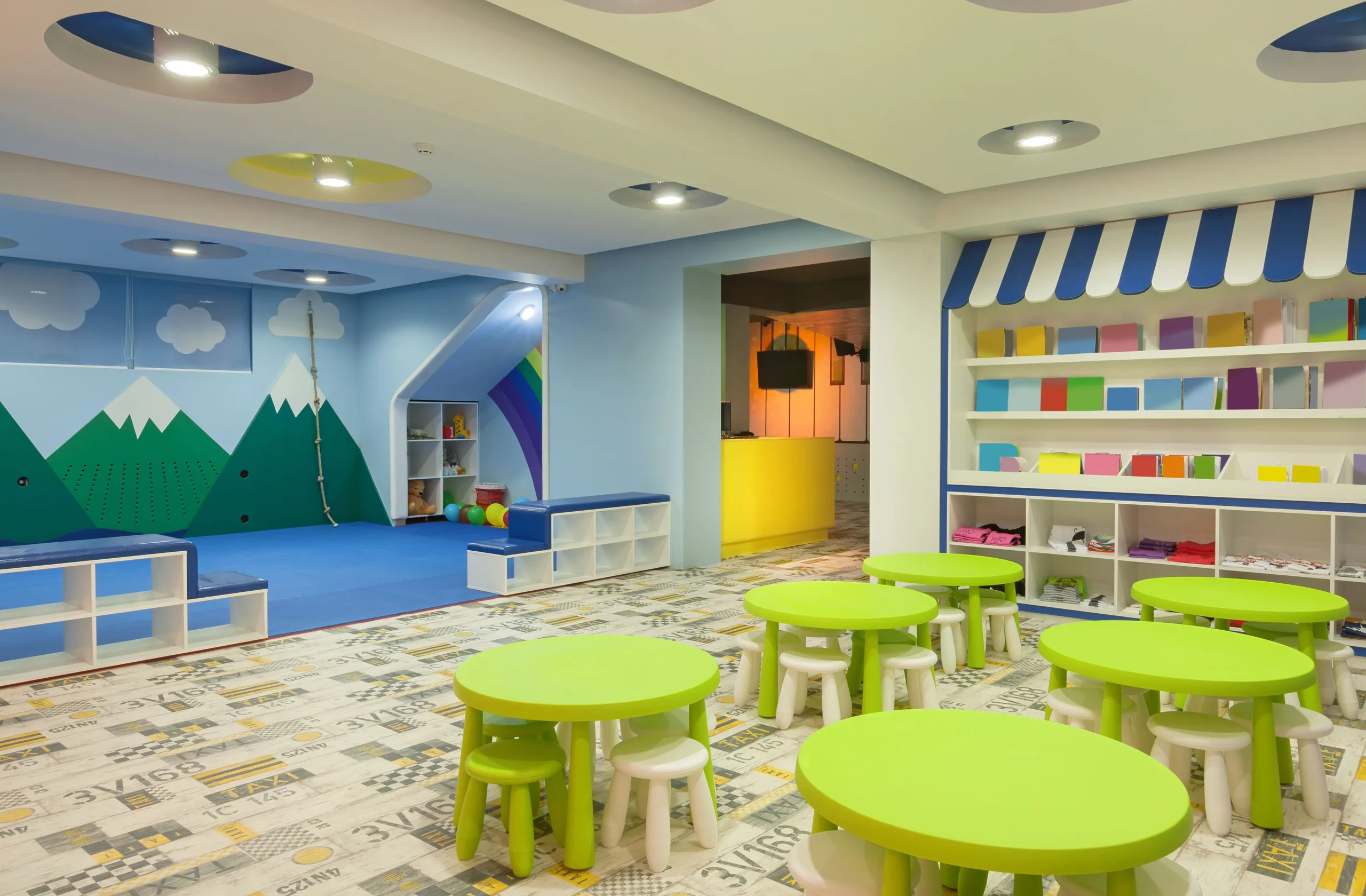
Tip #9 – Choose the Right Flooring.
Choosing the right flooring for your daycare center is also important. You will need to choose a material that is both safe and durable, as well as easy to clean. Options such as carpet, tile, and vinyl are all popular choices for daycare centers, depending on your specific needs and preferences.
Here are some pros and cons for each of the different types of flooring commonly used in daycare classrooms:
Carpet Pros and Cons
Pros:
-
- Soft and comfortable, providing a cushioned surface for children to play on
- Helps absorb noise, making the environment quieter
- Provides insulation, keeping the room warmer in cold weather
- Can come in a variety of colors and patterns, adding visual interest to the space
Cons:
-
- Can be difficult to clean and maintain, especially if spills or stains occur
- Can harbor allergens and bacteria if not cleaned regularly and thoroughly
- Can wear down quickly with heavy use, requiring frequent replacement
- May not be suitable for children with allergies or respiratory problems
Tile Pros and Cons
Pros:
-
- Durable and long-lasting, able to withstand heavy use and high traffic
- Easy to clean and maintain, with spills and messes able to be wiped up quickly
- Resistant to moisture and water damage, making it suitable for areas with sinks or water fountains
- Can come in a variety of colors and patterns, allowing for customization of the space
Cons:
-
- Hard and unforgiving surface, not as comfortable for children to play on
- Can be slippery when wet, posing a safety hazard
- May require regular waxing or sealing to maintain its appearance
- Can be noisy, with sound reverberating off the hard surface
VCT (Vinyl Composite Tile) Pros and Cons
Pros:
-
- Durable and long-lasting, able to withstand heavy use and high traffic
- Easy to clean and maintain, with spills and messes able to be wiped up quickly
- Resistant to moisture and water damage, making it suitable for areas with sinks or water fountains
- Can come in a variety of colors and patterns, allowing for customization of the space
Cons:
-
- Hard and unforgiving surface, not as comfortable for children to play on
- Can be slippery when wet, posing a safety hazard
- May require regular waxing or sealing to maintain its appearance
- May contain VOCs (volatile organic compounds) that can be harmful to children’s health
LVT (Luxury Vinyl Tile) Pros and Cons
Pros:
-
- Durable and long-lasting, able to withstand heavy use and high traffic
- Easy to clean and maintain, with spills and messes able to be wiped up quickly
- Resistant to moisture and water damage, making it suitable for areas with sinks or water fountains
- Can come in a variety of colors and patterns, including those that mimic natural materials like wood or stone
Cons:
-
- Hard and unforgiving surface, not as comfortable for children to play on
- Can be slippery when wet, posing a safety hazard
- May require regular waxing or sealing to maintain its appearance
- May contain VOCs (volatile organic compounds) that can be harmful to children’s health
Overall, each type of flooring has its own advantages and disadvantages. When choosing a flooring option for a daycare classroom, it’s important to consider factors like safety, durability, comfort, ease of maintenance, and potential health risks.
To best suit the needs of each room and activity, a combination of different flooring types is recommended for a daycare classroom. For areas that require frequent cleaning and disinfecting, such as restrooms, tile flooring is a good choice.
High-traffic areas like corridors, as well as areas where children eat, complete art projects, and play with tactile materials like sand and water, are best suited for waterproof LVT flooring.
For play areas, incorporating carpeting or throw rugs can offer more comfort and warmth. However, it’s important to note that carpeting requires more maintenance and cleaning to prevent allergens and bacteria buildup.
Finally, if cost is a major factor, VCT is an affordable option but requires regular waxing and buffing, which can be time-consuming and disruptive to the classroom. By carefully considering the needs of each space, a combination of flooring types can create a safe, comfortable, and functional environment for children in a daycare classroom.
Tip #10 – Include Ample Storage Space
When designing a daycare center, it is important to include ample storage space. This can help to keep the space organized and reduce clutter, which can be a distraction for children. Consider incorporating storage solutions such as shelves, cubbies, and cabinets to help keep toys and supplies organized and within easy reach.
Including ample storage space in a daycare building floorplan and classroom design is important for several reasons. See our article for Tips for Toy Storage as well.
Organization
Having adequate storage space allows for organization and easy access to materials and supplies. This helps to create a more efficient and productive environment for teachers and staff, as they can quickly locate the materials they need without wasting time searching through cluttered areas.
Cleanliness & Safety
Having designated storage spaces for toys, art supplies, books, and other materials helps to promote a clean and tidy classroom. This not only provides a more visually appealing environment for children, but it can also contribute to their health and safety by reducing the risk of tripping hazards and preventing the buildup of dust and allergens.
Functionality
Ample storage space can also contribute to the overall functionality of a classroom by creating more usable space. By keeping materials and supplies organized and out of the way, there is more room for children to move and play, which can contribute to a more engaging and enjoyable learning experience.
Incorporating ample storage space into a daycare building floorplan and classroom design is important for promoting organization, cleanliness, safety, and functionality.
Tip #11 – Choose Age-Appropriate Furniture
Choosing age-appropriate furniture is also important when designing a daycare center. Furniture should be sized appropriately for the age of the children you will be caring for and should also be durable and easy to clean. Consider incorporating furniture such as low tables and chairs, as well as comfortable seating for adults.
Choosing age-appropriate furniture for daycare classrooms is important for several reasons.
Physical Development
Children’s bodies are still developing, so using furniture that is designed for their age and size can help to prevent injuries and promote good posture. For example, chairs and tables that are too high or too low can cause discomfort and strain, while furniture that is too heavy or difficult to move can pose a risk of injury.
Learning Experience
Age-appropriate furniture can also contribute to the overall learning experience. For younger children, furniture that is colorful, soft, and tactile can help to stimulate their senses and encourage exploration and play. For older children, furniture that is more structured and functional can help to promote focus and concentration.
Independence & Self-Confidence
Additionally, using furniture that is appropriate for children’s age and size can also contribute to their independence and self-confidence. Furniture that is too large or difficult to maneuver can make children feel frustrated and helpless, while furniture that is designed with their needs in mind can help them to feel more capable and empowered.
In summary, choosing age-appropriate furniture for daycare classrooms is important for promoting safety, comfort, learning, and independence. By selecting furniture that is designed for children’s age and size, teachers and staff can create a more engaging and effective learning environment for children.
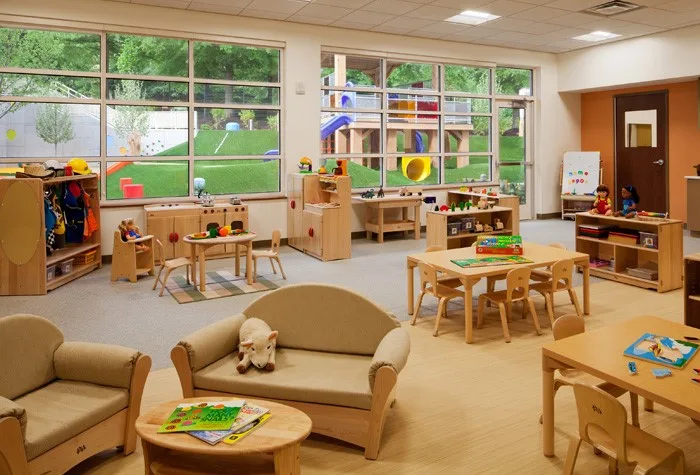
Tip #12 – Incorporate Technology.
Incorporating technology into your daycare center can also be beneficial. While it is important to limit screen time for young children, technology can be used to enhance learning and provide new opportunities for children to explore and discover. Consider incorporating technology such as interactive whiteboards, tablets, and educational apps into your space.
Incorporating technology like whiteboards and tablets in a daycare business and curriculum can be helpful for several reasons.
Interactive Learning
Technology can help to engage children and make learning more interactive and stimulating. For example, interactive whiteboards can allow teachers to create visually appealing presentations that capture children’s attention and encourage participation. Tablets can also provide interactive learning experiences through educational apps and games.
Personalized Learning
Technology can provide opportunities for personalized learning. By using tablets or other devices, teachers can create individualized learning plans that cater to each child’s strengths and weaknesses. This can help to foster a more supportive and effective learning environment.
Prepare for Future
Incorporating technology can help to prepare children for the future. As technology becomes more integrated into our daily lives, it is important for children to develop digital literacy skills and be comfortable using technology. By incorporating technology in the daycare curriculum, children can gain experience and confidence in using technology, which can be beneficial for their future academic and professional endeavors.
Administrative Benefits
Technology can also benefit daycare businesses by improving efficiency and communication. For example, digital communication tools can make it easier for parents and teachers to stay connected and share information. Online scheduling and billing systems can also help to streamline administrative tasks and reduce errors.
In summary, incorporating technology like whiteboards and tablets in a daycare business and curriculum can be helpful for engaging children, providing personalized learning opportunities, preparing children for the future, and improving staff efficiency and communication.
Tip #13 – Consider Safety Features.
When designing a daycare center, safety should always be the top priority. The floorplan should be designed to minimize risks and hazards that could harm children.
Safety features are an essential consideration when designing a daycare center. You will need to plan for everything from child-proofing electrical outlets to installing secure locks on doors and windows. Consider working with a professional to ensure that your space is designed with safety in mind.
Here are some tips to help ensure safety in daycare center design:
Use non-slip flooring materials.
Slips, trips, and falls are among the most common accidents in daycare centers. To minimize the risk of falls, non-slip flooring materials should be used. Such materials include rubber, cork, and linoleum.
Provide adequate lighting.
A well-lit daycare center is not only welcoming but also promotes safety. Adequate lighting helps to prevent accidents and enables caregivers to monitor children effectively.
Ensure clear sightlines.
The floorplan should be designed to provide clear sightlines between the children and caregivers. This ensures that caregivers can always keep an eye on the children, reducing the risk of accidents.
Use safety equipment.
Safety equipment such as smoke detectors, fire extinguishers, and first aid kits should be provided in the daycare center. This equipment should be easily accessible and regularly maintained.
Tip #14 – Create a Comfortable Environment.
Finally, it is important to create a comfortable environment for children and staff alike. There are several elements that can be included in a daycare building to create a comfortable environment for children:
Natural Light
Natural light can create a warm and inviting atmosphere, which can help children feel comfortable and relaxed. Large windows and skylights can be incorporated into the building design to allow for ample natural light.
Soft Flooring Areas
Soft and cushioned flooring, such as throw rugs or rubber play mats, can provide a comfortable surface for children to play and move around on. This can also help reduce noise levels and create a more peaceful environment.
Warm Colors
Warm colors, such as pastel tones, can create a calming and soothing atmosphere. They can be used on walls, furniture, and decor to create a warm and welcoming space.
Comfortable Furniture
Comfortable and child-friendly furniture, such as soft seating and bean bags, can create a cozy and inviting atmosphere for children to relax and read or participate in quiet activities.
Indoor Plants
Indoor plants can help create a natural and calming environment. They can also help purify the air and improve indoor air quality.
Quiet Areas
Quiet areas, such as reading nooks or soft play areas, can provide children with a space to relax and unwind. These areas can also help reduce noise levels and create a more peaceful environment.
Temperature Control
Temperature control can help create a comfortable environment throughout the year. Air conditioning and heating systems can be incorporated into the building design to provide a consistent and comfortable temperature.
Including these elements in a daycare building design can create a comfortable and inviting environment for children to learn, play, and grow. Creating a comfortable environment within a daycare building floorplan and interior design is important for several reasons:
Promotes Child Development
A comfortable environment can promote children’s physical, social, emotional, and cognitive development. When children feel comfortable and safe, they are more likely to explore their surroundings, engage in play and learning, and develop positive relationships with caregivers and peers.
Reduces Stress
A comfortable environment can help reduce stress for both children and caregivers. A well-designed space can create a sense of calm and security, which can help children feel more relaxed and caregivers more focused on their work.
Encourages Positive Behaviors
A comfortable environment can help promote positive behaviors among children. When children feel comfortable and secure, they are more likely to be cooperative, respectful, and engaged in their activities.
Supports Health
A comfortable environment can support children’s physical health by ensuring that the space is clean, well-ventilated, and safe. It can also support children’s mental health by creating a warm and welcoming atmosphere that promotes a sense of belonging.
Attracts and Retains Families
A comfortable environment can help attract and retain families. When parents feel that their children are safe and happy in the daycare center, they are more likely to continue using its services and recommend it to others.
Overall, creating a comfortable environment within a daycare building floorplan and interior design is important for promoting child development, reducing stress, encouraging positive behaviors, supporting health, and attracting and retaining families.
-This article was written by Rebecca Calbert.
Rebecca is a licensed architect with over 30 years of experience. She owns and operates an architectural firm, Calbert Design Group, and educates her clients through the commercial real estate development process with online content at SaveOnBuilding.com. Rebecca’s “purpose” is to educate small business owners and protect them from what they don’t know.

